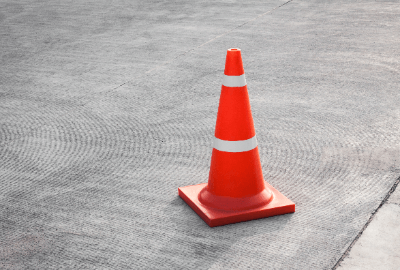What Is a Safety Cone?

A Safety Cone is a conical safety device with a height of approximately 70 cm.
Primarily deployed for regulation and demarcation in areas such as roads and construction sites, the use of 700mm-high Safety Cones is stipulated in road construction, aligning with the “Road Construction Safety Facility Installation Standards.” Safety Cones fall under the category of “safety facilities,” mandated for installations to facilitate traffic guidance and access prevention.
Safety Cones come in colors not limited to red or vermilion; there are variations with black and yellow stripes or designed to blend with the surroundings, catering to different locations and purposes. Additionally, larger sizes, approximately 120 cm or 180 cm in height, exist beyond the usual dimensions.
Uses of Safety Cone
Safety Cones find utility in various applications, particularly at construction sites. They are used to manage pedestrian flow during festivals or events, and in sports, they serve as markers or guides for athletes.
Besides guiding and organizing parking lots, Safety Cones are employed to reserve spaces. They are used in driving schools for practice, and in gymkhanas, the arrangement of cones is often used to design technical courses.
Available in home improvement stores, Safety Cones are also employed in households to prevent unauthorized parking. There are also convenient, flat-foldable Safety Cones. Giant types exceeding 2 meters in height are utilized at the start of highway construction zones or turnaround points in marathons.
For enhanced visibility during nighttime, reflective sheets are sometimes applied to Safety Cones. There are also self-luminous types using LEDs, with openings at the top for inserting guide rods or signal lights to improve visibility through transmitted light.
Characteristics of Safety Cone
The hollow interior of the conical section of Safety Cones, open at the bottom, allows for space-saving stacking during transport and storage, a common feature in many types. Synthetic resin materials like rubber or polyvinyl chloride (PVC) are often used for high-speed lane regulations on highways and wind resistance. These materials exhibit high friction with road surfaces, providing weight and elasticity.
Traditional thermoplastic resins used for Safety Cones have low weather resistance. There is a possibility of cracking and damage during long-term use or in cold climates. Rubber or EVA resin is chosen for cold weather resistance. EVA has flexibility, remains relatively soft even in cold weather, and has a low probability of damage.
Types of Safety Cone
Safety Cones are mainly made of plastic or rubber, and specific examples of materials include low-density polyethylene (LDPE), high-density polyethylene (HDPE), soft polyvinyl chloride (PVC), and EVA resin. The choice of material depends on the intended use and budget.
1. Low-Density Polyethylene (LDPE)
Also known as soft polyethylene, LDPE exhibits flexibility and excellent low-temperature resistance, making it less prone to brittle fracture even in extremely cold conditions (up to -20°C). It is mechanically strong.
2. High-Density Polyethylene (HDPE)
HDPE is rigid and has excellent stiffness. Its heat resistance temperature is typically 90–110°C. It has higher crystallinity compared to LDPE, making it slightly heavier but lighter than water. Similar to LDPE, it has acid resistance, alkali resistance, and electrical insulation properties. It excels in rigidity and heat resistance compared to LDPE.
3. Soft Polyvinyl Chloride (PVC)
Soft PVC, also known as Polyvinyl Chloride (PVC), is a material softened by adding plasticizers to PVC.
4. EVA Resin
EVA resin stands for Ethylene-Vinyl Acetate copolymer. It is softer and more elastic than polyethylene, lightweight, and environmentally friendly.